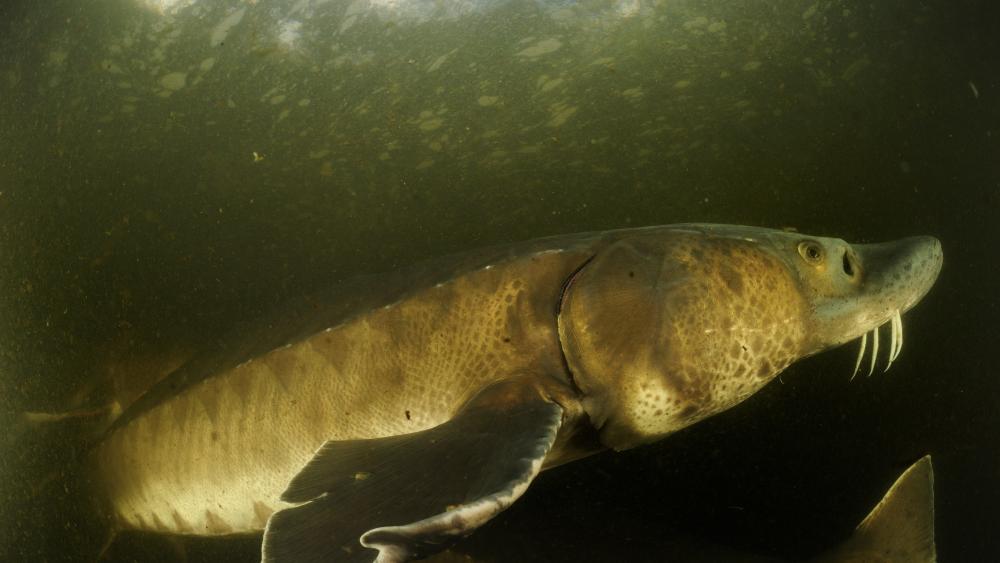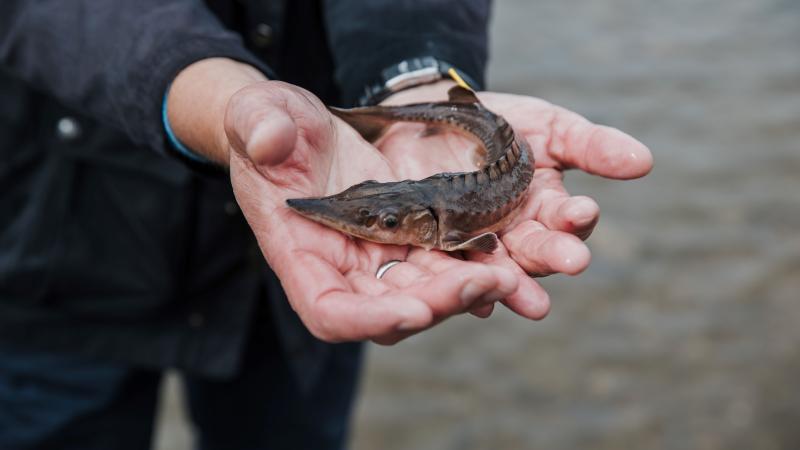
The European sturgeon (Acipenser sturio) was once native to Germany and is now considered extinct. The IGB coordinates the national reintroduction programme. | Photo: Solvin Zankl
Globally, twenty-six species of sturgeon have survived - for now. The twenty-seventh species, the Chinese paddlefish (Psephurus gladius), was declared extinct in 2020. The main reason for its extinction, once endemic to China’s largest river, was dam construction – most notably the Gezhouba Dam on the main branch of the Yangtze River, about 1,600 kilometres from its estuary. This dam has no fish ladders or other bypasses and has cut off the Chinese paddlefish from its upstream spawning grounds. The damming of rivers and the associated loss of habitat is one of the main causes of the global decline of the sturgeons. All sturgeons are migratory fish that travel long distances between their spawning grounds in the middle and upper reaches of rivers and their feeding grounds in the lower reaches or the sea. This strategy helps them to spatially segregate different age classes and maintain large populations, but makes them vulnerable to disturbance during their migrations.
Bypassing dams is life-saving
Dam removal is the most effective way to reintroduce sturgeon to rivers, as shown by the examples of Edwards Dam on the Kennebec River in Maine and Ballville Dam on the Sandusky River in Ohio. In both cases, sturgeon returned to the upper reaches of the rivers almost immediately after the dams were removed. But instead of building fewer dams, rivers around the world are becoming more fragmented: More than 3,400 large hydroelectric dams are either planned or already under construction, according to a study led by IGB from October 2021.
"As the number of hydropower plants will continue to increase, it is important to effectively mitigate their impacts in order to maintain and restore sturgeon and not only sturgeon migration," said IGB researcher Jörn Gessner. For more than 20 years, the scientist has been leading projects to reintroduce two sturgeon species, which were once native to the North and Baltic seas.
Fish ladders, lifts and other fish passes are not suitable for sturgeon
Most fish ladders at dams and weirs were built for relatively small and fast swimming fish species that use small rivers and streams for breeding, such as salmon and sea trout. Sturgeon do not spawn until they are at least ten years old and are often over one and a half meters long, but can grow to over four meters. They live in large rivers and need a lot of space to overcome migration barriers. "The efficiency of most conventional fish ladders – even when modified for sturgeons – is very low, with less than two percent of sturgeons using them in most cases monitored," explained Jörn Geßner.
Recommendation for action: Migration corridors adapted to sturgeon behaviour
Sufficiently dimensioned channels, which allow the sturgeon to bypass the obstacles, can serve as additional habitats in which the sturgeon can also reproduce. An international team of authors from China, Canada, Italy, Denmark and Germany has described how such bypass channels should be designed: The bypass channels should be hydromorphologically similar to a natural river course and long enough to provide suitable gradients and flow conditions for sturgeon. Entrances should be located in areas downstream of the weir where sturgeon search for migration routes to use them, while exits should allow bypassing a large part of the reservoir upstream of the weir. During the spawning and juvenile migration period, up to 35 per cent of the available flow should be directed into the channel, as migrating fish require facilities of sufficient size and with sufficient flow provide sufficient incentive to use it.
These bypass channels can also act as life insurance for many species threatened by river fragmentation – not just fish. They can also promote sediment transport, minimising the bed erosion typical of dams. Measures to mitigate the negative impacts of hydropower should always be planned and financed.
"Migration corridors for sturgeon should be standard along rivers where they are native. The construction of migration corridors requires considerable investment and effort, which must be included in the overall calculation of hydropower plants. However, these costs are often not considered, or only for minimal options," said Jörn Gessner.
Positive examples of bypassing weirs already exist
Several successful examples of near-natural bypass channels support the researchers' recommendations. On the Namakan River in Ontario, Canada, a near-natural channel has been constructed that consists of a series of rapids, stretches over two kilometres and has an average water depth of seven metres. Genetic analysis has confirmed that lake sturgeon (A. fulvescens) use the channel to migrate upstream, helping to maintain their population in the river.
A near-natural bypass channel for sturgeon was built to bypass the Konstantinovskiy dam on the Don River in Russia. The channel is six kilometres long, 22 metres wide and two metres deep on average. Evidence of up to 2,500 sturgeon ascending and evidence of starry sturgeon (A. stellatus) spawning has led to new bypass channel projects being planned at other Don dams.
The most recent promising case study comes from Montana, where a 3.4 km side channel to the Lower Yellowstone River has been constructed at Intake Diversion Dam. Three wild, mature pallid sturgeon (S. albus) and nine tagged individuals of this endangered species swam through the channel within weeks of its completion.






